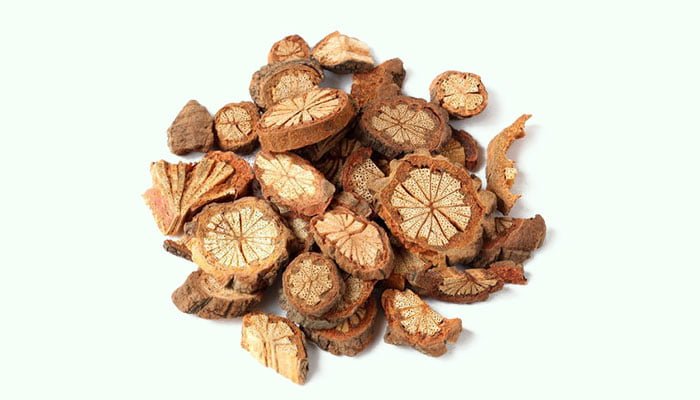What Is Hong Teng
Hong Teng is also known as Da Xue Teng or Sargentodoxa Cuneata, which is a deciduous woody liana belonging to the family Lardizabalaceae. It is a practical Chinese herbal medicine, which first appeared in <Tu Jing Ben Cao>(Illustrated Classic of Materia Medica) in the 11th century.
Sargentodoxa Cuneata likes a light, warm and humid environment. They grow well in the loose, fertile, acidic sandy soil rich in organic matter. They often grow on hillsides, shrubs, sparse forests, or forest edges hundreds of meters above sea level. They can be found in China and the northern part of the Indochina Peninsula.
This plant has a certain ornamental value and economic value. They are ornamental plants often grown in gardens in tropical and subtropical regions of China. Their stem bark contains fibers and can be made into ropes.

In autumn and winter, people gather caulis of Sargentodoxa Cuneata, remove their lateral branches and leaves, cut them into thick pieces, dry them in the sun, and make them into Chinese herbal medicines.
Hong Teng contains feruloyltyramine, p-hydroxyphenylethanol ferulate, p-hydroxyphenylethanol p-coumarate, acanthoside D, eleutheroside E1, chlorogenic acid, methyl chlorogenate, chlorogenic ethyl ester, proanthocyanidins, rhodioloside, vanillic acid, gallic acid, syringic acid, glucosyringic acid, salidroside, apocynin, epicatechin, rosamultin, oleanolic acid, madasiatic acid, daucosterol, β-sitosterol, α-cadinol, δ-cadinol, α-amorphene, emodin, emodin monomethyl ether, chrysophanol, ionone glycoside, flavonoids, and tannins.
Generally, Hong Teng with the outer skin is rough and gray-brown, the outer part of the cut surface is reddish-brown, and the inner part of the cut surface is yellow-white, and the radial texture is preferred.
According to <Ben Cao Tu Jing>, the medicinal nature of Hong Teng is relatively neutral, with a bitter taste. It has a certain therapeutic effect on the pathological changes of the large intestine and liver meridians.
In traditional Chinese medicine (TCM), it is often used to clear heat and remove toxins, promote blood circulation, dispel wind and relieve pain, treat acute appendicitis, early suppurative appendicitis, appendix abscess, adhesive intestinal obstruction, irregular menstruation, amenorrhea, dysmenorrhea, metrorrhagia, ovarian cyst, salpingitis obstructive acyesis, chronic pelvic inflammatory disease, endometriosis, peptic ulcer, acute pancreatitis, chronic suppurative osteomyelitis, rheumatoid arthritis, gouty arthritis, biliary ascariasis, and bruises.
There are about 50 kinds of Chinese medicine prescriptions containing it, such as Fule granules, Lan Wei Xiao Yan Pian, and Fubao granules.
Benefits
- Anti-inflammation, inhibiting xylene-induced ear swelling in mice.
- Extending the latency of pain threshold in acetic acid-induced pain model mice and reducing the number of writhing times in mice.
- Anti-oxidation, scavenging DPPH free radicals.
- Inhibiting the growth of mouse breast cancer tsFt210 cells and K562 cells.
- Inhibiting the transformation of T cells into effector cells and the activity of macrophages, and resisting the delayed-type hypersensitivity induced by DNCB.
- Inhibiting platelet aggregation, increasing coronary flow, and preventing thrombosis.
- Reducing the scope of myocardial infarction, improving myocardial lactic acid metabolism caused by myocardial infarction, and expanding the coronary arteries.
- Improving plasma cAMP level, treating cerebrovascular dysfunction and coronary heart disease.
- Dispersing blood stasis in the intestines, and relieving abdominal pain caused by acute appendicitis.
- Removing heat toxins, treating sores and ulcers caused by heat toxins.
- Promoting blood circulation and removing blood stasis, treating bruises.
- Treating amenorrhea and dysmenorrhea caused by blood stasis.
- Dispelling wind, treating low back and leg pain, inflexibility of joints, and pain of rheumatic arthralgia.
- Its alcohol extract and water extract can inhibit the activity of xanthine oxidase, reduce the production of uric acid, and treat gout.
- Its injection can significantly improve the survival time of mice under normal pressure hypoxia or decompression hypoxia, and can significantly reduce the autonomous activities of mice and increase the hypnotic time of pentobarbital.
- Studies have found that its total saponins and chlorogenic acid can improve the microcirculation blood flow of the small intestine tissue of rats, increase the blood perfusion of tissues and organs, reduce the content of hydroxyproline in the adhesion tissue, and reduce the formation of adhesions. It can reduce the degree of adhesions in the abdominal cavity.
- Inhibiting Staphylococcus aureus, Bacillus subtilis, Escherichia coli, Klebsiella pneumoniae, Enterococcus faecalis, and Pseudomonas aeruginosa.
Combinations
- It can be used in combination with Dang Gui (Radix Angelicae Sinensis), Xiang Fu (Rhizoma Cyperi), Yi Mu Cao (Leonurus Japonicus), etc. to treat amenorrhea and dysmenorrhea.
- It can be used in combination with Zhi Shi (Fructus Aurantii Immaturus), Da Huang (Radix et Rhizoma Rhei), Shan Zha (Hawthorn Fruit), etc. to treat acute pancreatitis.
- It can be used in combination with Du Huo (Radix Angelicae Pubescentis), Niu Xi (Radix Achyranthis Bidentatae), Fang Feng (Radix Saposhnikoviae), etc. to relieve low back and leg pain, inflexibility of joints, and pain of rheumatic arthralgia.
- It can be used in combination with Bai Jiang Cao (Patrinia), Zi Cao (Radix Arnebiae), etc. to reduce the lumps in the appendages and uterine, treat dysmenorrhea, and endometriosis.
- It can be used in combination with Lian Qiao (Fructus Forsythiae), Jin Yin Hua (Flos Lonicerae), Chuan Bei Mu (Fritillaria cirrhosa), etc. to treat sores and ulcers caused by heat toxins.
Side Effects
- Currently, there is no information showing that it is poisonous.
- Long-term or excessive use of it may cause gastrointestinal discomforts, such as abdominal pain or diarrhea.
Precautions and Warnings
- The dosage of Hong Teng should be controlled at 9-15g.
- It can be made into decoctions or ground for external use.
- People who are allergic to Hong Teng should not take it.
- You should not take it before or during surgery.
- Pregnant women, breastfeeding women, and menstruating women should not take it.
- Patients with deficiency-cold in the spleen and stomach should not take it.
- Patients with coagulopathy should not take it.
